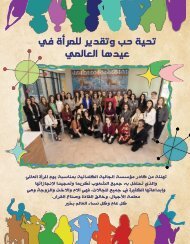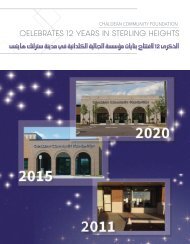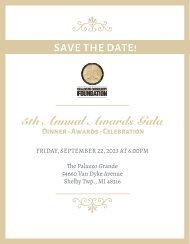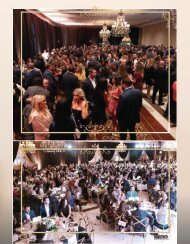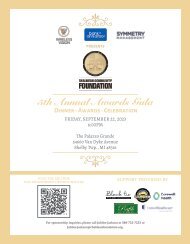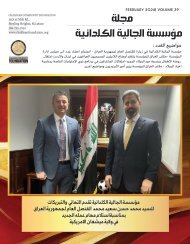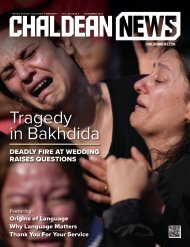MARCH 2017
MARCH 2017
MARCH 2017
You also want an ePaper? Increase the reach of your titles
YUMPU automatically turns print PDFs into web optimized ePapers that Google loves.
ARTS & entertainment<br />
Artistic<br />
Therapy<br />
BY WEAM NAMOU<br />
Cassidy Kassab<br />
Always having been drawn to<br />
service and art, Cassidy Kassab<br />
found a way to naturally<br />
combine her two passions into the<br />
career of art therapy. The 25-year-old<br />
Michigan native received her BA in<br />
Studio Art from Oakland University<br />
and is currently working on her MA<br />
in Art Therapy at the School of the<br />
Art Institute of Chicago.<br />
“You can use art in the healing<br />
profession,” Kassab said.<br />
Art therapy is a method of psychotherapy,<br />
involving the encouragement<br />
of free self-expression, through<br />
painting and other artistic ways. Clients,<br />
facilitated by the art therapist,<br />
use the creative process and the resulting<br />
artwork to explore their feelings,<br />
reconcile emotional conflicts,<br />
foster self-awareness, manage behavior,<br />
reduce anxiety, and increase<br />
self-esteem. A goal in<br />
art therapy is to improve or<br />
restore a client’s functioning<br />
and his or her sense of<br />
well-being.<br />
“People don’t go into<br />
this field to make money,”<br />
she said. “They go into it<br />
because it’s truly who they<br />
are, it’s a calling. You have<br />
to want to serve people.”<br />
Although contemporary<br />
art therapy is a fairly new<br />
practice, art has been used<br />
since the beginning of human history<br />
as a medium for communicating<br />
thoughts and ideas. The oldest cave<br />
painting was found in El Castillo cave<br />
in Cantabria, Spain and dates back<br />
40,000 years to the Aurignacian period.<br />
Though researches are uncertain<br />
as the exact purpose of the cave drawings,<br />
it has been theorized that they<br />
were likely used as part of religious<br />
ceremonies or to reach out to others<br />
in the area.<br />
The youngest of four children,<br />
Kassab was born in Rochester to<br />
Sam and Faye. Being open-minded<br />
and having a healthcare business<br />
themselves, her parents were very<br />
supportive of her career choice, although<br />
they didn’t fully<br />
understand it.<br />
“Eventually, they understood<br />
that it’s a counseling<br />
profession,” she said. “It’s<br />
important to acknowledge<br />
that our Chaldean Assyrian<br />
Babylonian ancestors have<br />
an extensive history of an<br />
art practice. It’s unfortunate<br />
that art is not as respected<br />
or as valued in our culture,<br />
and in a lot of cultures, not<br />
just in the Middle East.<br />
That’s because art is a luxury.”<br />
She explained that when people<br />
come from Iraq to the United States,<br />
for instance, their life’s circumstances<br />
cause them to focus on ways they<br />
could feed and support their family,<br />
raise their children and put them<br />
through college. Those who finally<br />
have the opportunity to go to college,<br />
will often choose careers that will<br />
help support their family.<br />
But Kassab points out that, regardless<br />
of the vocation one chooses, creativity<br />
is an important skill than can<br />
increase one’s IQ, helps calm the brain,<br />
and has many other beneficial factors.<br />
According to Hennessey & Amabile<br />
(2010), creativity is a concept<br />
Clockwise from top left: Passion; Padre Pio; Sacred Heart; Art on display; Agnus Dei.<br />
of individual differences, which is<br />
intended to explain why some people<br />
have higher potential to provide<br />
new solutions to old problems than<br />
others. It leads people to change the<br />
way they think about things and is<br />
conceived as the driving force that<br />
moves civilization forward.<br />
Kassab’s main passion is digital<br />
media and graphic illustration, but<br />
she also works with mixed media<br />
including ink, watercolor, oil, and<br />
acrylic paint. She works heavily with<br />
religious and spiritual concepts, as<br />
well as political and human rights<br />
activism. Her most recent body of<br />
work is entitled Building Relationship<br />
where she created a survey and<br />
submitted it to all the therapists and<br />
clients at DePaul Family and Community<br />
Services, asking them, “What<br />
is it that helps you feel connected to<br />
your client or therapist?”<br />
The therapists and clients responded<br />
similarly. Their main interests<br />
in having a strong relationship<br />
included comfort, humor, understanding<br />
and empathy, strength and<br />
perseverance together, and affirmation<br />
and validation.<br />
Kassab said the most challenging<br />
part of art therapy is burnout, which<br />
happens with a lot of mental health<br />
professionals.<br />
“You’re not only using your mind<br />
and skills, but all of your senses to<br />
deliver a service,” she said. “It can<br />
at times be emotionally draining, so<br />
I learned to take care of myself in<br />
a very intense way in order to constantly<br />
be available, with compassion,<br />
toward those I work with.”<br />
Kassab plans to return to her<br />
community in Michigan, after she<br />
graduates this May, and start a type<br />
of arts ministry.<br />
“I’m interested in creating a program<br />
for refugees and doing traumabased<br />
work for children and adolescence,”<br />
she said. “When you are<br />
dealing with trauma, it’s very difficult<br />
to assimilate to a new country based<br />
on what you experienced.”<br />
To serve this community best, she<br />
wants to learn Arabic and Sureth so<br />
she can better communicate with the<br />
refugees.<br />
“They say that if you can understand<br />
poetry in another language,<br />
you can provide therapy,” she said.<br />
“That’s because if you can understand<br />
the nuances of the poem, then<br />
you can understand the nuances of<br />
another culture.”<br />
30 CHALDEAN NEWS <strong>MARCH</strong> <strong>2017</strong>




